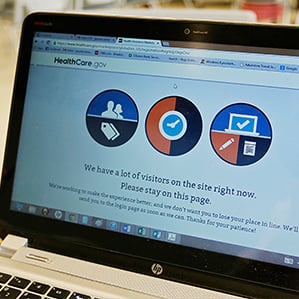Diagnosis for Healthcare.gov: Unrealistic Technology Expectations
The fiasco with the $600 million federal health insurance website wasn’t all bureaucratic. Forcing slow and disparate databases run by government and insurance companies to work together in real time—and then launching the service all at once—would have challenged even technology wunderkinds.

In particular, the project was doomed by a relatively late decision that required applicants to open an account and let the site verify their identity, residence, and income before they could browse for insurance. That meant the site would have to interface in real-time with databases maintained by the Internal Revenue Service and other agencies.
“You could put 100 Google engineers on it, and it’s not going to fix [the fact] that the scope of the project is flawed or fix the IRS system if it’s slow,” says John Halamka, chief information officer of Beth Israel Deaconess Medical Center in Boston. “You don’t want to query 10 downstream systems and be reliant on their performance, because you are only going to be as good as the slowest one.”
This problem did not plague many of the health-care exchanges at the state level. For example, the Massachusetts system lets you shop for insurance anonymously, and even apply for an insurance policy without setting up an account. Identity confirmation is done later, before the policy becomes effective. Similarly, the exchange in Kentucky—which, like the federal website, went live on October 1—didn’t require users to set up an account or verify their identity before enrolling.
The New York state exchange does require people to verify their identity and set up an account before enrollment, but the state had planned for this and had ID systems in place, says Greg DeBor, managing director at Manatt Health Solutions, which assisted the state with policy and design matters related to the exchange.
These state and federal websites are the key to the implementation of the Affordable Care Act, often called Obamacare. The law calls for state-specific health insurance exchanges—websites where people can compare prices and purchase private health insurance or determine if they are eligible for Medicaid. If states do not set up their own exchanges—34 did not—their residents must use the federal government’s site, healthcare.gov, which crashed and was widely inaccessible after it went live on October 1.
On September 26, President Obama hinted of no problems and compared healthcare.gov to popular e-commerce sites. “Now, this is real simple,” he said. “It’s a website where you can compare and purchase affordable health insurance plans side by side the same way you shop for a plane ticket on Kayak, same way you shop for a TV on Amazon. You just go on, and you start looking, and here are all the options.”
But beyond the president’s cluelessness about the looming problems, his analogy fails because on both Amazon and Kayak, you can dive in and start shopping without the website first having to query numerous federal databases. E-commerce sites also are willing to postpone certain details. For example, Amazon will immediately send you an e-mail to confirm your purchase and then later send you one with a UPS tracking number, after it’s made the link to a UPS database.
In contrast, the federal site took on complications that would befuddle even the best technologists. “The scope of ‘we will provide all the functionality for 34 states, and linkage to 1,000 insurance companies, and an online real-time marketplace’ was probably too big to accomplish given the time available,” Halamka says.
DeBor says the technological challenge was exacerbated by the administration’s demand that every element of the hugely complex site be ready at once. “The requirements [for the site] came out very late, and they were all predicated on everything being ready at once. With those two things, it made it hard for anybody to deliver on this,” he said. “It was the ‘big bang’ approach: we have to do everything and have everything ready on October 1.”
But fixes are possible, and are slowly underway. The Center for Medicare and Medicaid Services, which oversees the site, is adding storage capacity to speed application processing. And the agency has been implementing dozens of software upgrades to do things like make databases work together better and to fix issues that only became evident after the October 1 “big bang.”
The administration was predicting that the site could handle 50,000 visitors at a time by the Thanksgiving weekend, when its self-imposed December 1 deadline for site fixes arrived. Even so, it delayed a marketing campaign to avoid a crush of new users—which could still paralyze the site.
Keep Reading
Most Popular
Large language models can do jaw-dropping things. But nobody knows exactly why.
And that's a problem. Figuring it out is one of the biggest scientific puzzles of our time and a crucial step towards controlling more powerful future models.
The problem with plug-in hybrids? Their drivers.
Plug-in hybrids are often sold as a transition to EVs, but new data from Europe shows we’re still underestimating the emissions they produce.
Google DeepMind’s new generative model makes Super Mario–like games from scratch
Genie learns how to control games by watching hours and hours of video. It could help train next-gen robots too.
How scientists traced a mysterious covid case back to six toilets
When wastewater surveillance turns into a hunt for a single infected individual, the ethics get tricky.
Stay connected
Get the latest updates from
MIT Technology Review
Discover special offers, top stories, upcoming events, and more.